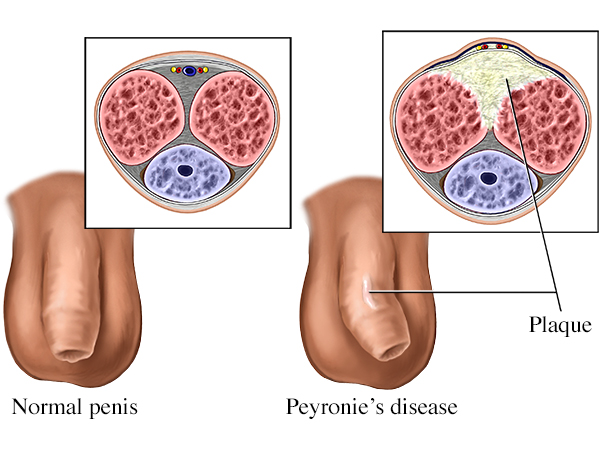Peyronie’s Disease
Peyronie’s disease is a common problem (approximately 5%) seen mostly in middle-aged men, although men of any age are susceptible to the problem. Peyronie’s disease often has as much or more of a psychological impact than a physical one. It represents a scarring of the tough tissue that comprises the two erectile bodies of the penis, known as the corpora cavernosa. The tissue that scars is called the tunica albuginea. Although at times a patient can recall an injury to the penis preceding the problem, usually during sexual activity, the most common presentation is that it forms spontaneously in men that are starting to have less firm yet still useful erections. It is theorized that small tears occur in the tunica albuginea during sex that the body heals by laying down scar. At times, this scarring can be part of a more global syndrome and is seen in patients that have scarring of the tendons in their hands called DePuytren’s contractures.
Symptoms of Peyronie’s Disease

A patient with Peyronie’s disease will first notice pain in the penis during erections that is described as a soreness that can at times be considerable. This is the inflammatory response that ultimately, usually within a few weeks or months of the pain starting, produces a scar that can be palpated in the flaccid penis. This scar is called a Peyronie’s plaque. Once the scar matures, the inflammation subsides, and the soreness usually resolves. As seen in the schematic shown, most plaques are located at the top of the penis. Approximately 20% will eventually become calcified.
The hallmark of Peyronie’s disease is penile deformity. This is most commonly seen as curvature of the erect penis produced as a result of the plaque not allowing expansion of the tunica albuginea at its location. However, this fixation of the tunica can also cause a waisting of the penis where it is constricted, shortening of the penis, or an unstable area of the penis while erect that causes it to hinge at that spot. The deformity is dictated by the shape and location of the plaque, and as the plaque develops the manifestation of the deformity can change as well. Peyronie’s disease rarely causes erectile dysfunction on its own unless severe, but can amplify any degree of erectile dysfunction a man already has by replacing the normal erectile tissue with a scar and thus disallowing free flow of blood throughout the entire corporal body, thus causing less rigidity.
Prognosis of Peyronie’s Disease
The vast majority of patients need to be reassured that the plaque is not a tumor and will not affect their lives negatively. In almost all cases, pain resolves with time alone, and any curvature or deformity that exists does not progress to the point that it makes sexual activity difficult.
Once noticed, many patients seek advice from an Urologist. The vast majority of patients need to be reassured that the plaque is not a tumor and will not affect their lives negatively. In almost all cases, pain resolves with time alone, and any curvature or deformity that exists does not progress to the point that it makes intercourse difficult. It is the change to a man’s penis and the resulting fear that it will progress in severity to the rare worst-case scenario that makes the largest negative impact. Of all cases at presentation, approximately 20% will actually remodel and improve on their own, 40% remain stable and 40% worsen. But, even for those men that worsen, the minority will progress to the point where they must seek treatment for Peyronie’s Disease to be able to have fulfilling sexual activity. Indeed, we find that most commonly, when a man comes for a consultation, in truth, the problem is more centered around erectile dysfunction and not penile deformity. In these circumstances, we focus far more on offering ED treatments that improve erections than treatments for Peyronie’s disease. Usually, once a man achieves a good erection he no longer seeks help for penile scarring.
Medications & Supplements To Treat Peyronie’s Disease
It is this anxiety, and not necessarily physical deformity, that tends to drive men to seek non-surgical treatment. Unfortunately, there are very little data to support the use of oral remedies for Peyronie’s disease, but many men find the concept of simply accepting a minor curvature of the penis and not seeking some form of prospective therapy unacceptable. A partial list of such remedies would include Potaba, colchicine, Vitamin E, marketed herbal remedies, Coenzyme Q, and most recently Pentoxyfylline and L-Arginine. Dr. Engel does not discourage a man from trying these remedies as long as they are not overly expensive (Potaba) or cause side effects (colchicine). Pentoxyfylline, an old anti-hypertensive named Trental, has the most recent literature with some data supporting its use. Vitamin E is the simplest thing for a man to try. But in reality, Dr. Engel believes that it is time and one’s own body that will determine if the plaque will worsen, remodel, stabilize or calcify. Since in most men, the problem is physically a minor one, we feel that de-emphasizing this in one’s life rather than keeping the problem and the anxiety associated with it in the forefront by taking meds several times a day that have little efficacy is the healthiest approach.
Next Steps
The approach that Dr. Engel takes is to have the patient decide if their degree of deformity is actually getting in the way of sexual activity. A distinction is made between this physical problem, and a situation where a man is suffering from the anxiety that can surround not knowing the future, or a struggle with one’s body image in that although one’s penis is fully functional it is the change that is causing anxiety. Dr. Engel also makes sure a patient is not simply seeking to improve erections. Here, getting a better erection is addressed primarily as mentioned above, and not the Peyronie’s disease.
However, there are times when more aggressive treatment for Peyronie’s disease is very reasonable, and generally, the first real steps include injections of medicine directly into Peyronie’s plaque in an effort to soften the scar. This can be to lessen curvature or to allow for better blood flow. There are now three medicines with evidence of efficacy, and all are similar. Verapamil was the first to be shown to be able to soften scar. It is an anti-hypertensive drug but has the property of inducing one’s own scar cells called fibroblasts to remodel scar by producing collagenase. These injections are inexpensive and generic and are Dr. Engel’s mainstay when there is no severe curvature. These are given as injections in the office every two weeks for a total of twelve injections. We look for efficacy after the sixth injection, and if the scar is softening, we proceed with the full twelve.
Also reported have been alpha-interferon injections, which have a similar effect. These are far less accessible and are far less commonly performed than verapamil. More recently, an FDA-approved drug called Xiaflex was released and heavily marketed. This is an actual bacterial version of collagenase. To have this approved by insurance, certain specific parameters must be met in terms of curvature angle and duration of the problem. Dr. Engel will use this when approved but sees little advantage over verapamil after extensive experience with both. Xiaflex also carries with it some risk, including penile fracture.
Patients must understand that with all injection therapy, in general, there is improvement just over 60% of the time and that improvement in curvature may not mean that the patient’s difficulty with intercourse is truly addressed. We institute a combined penile traction program with all injections, which has been shown to increase the success rate slightly. Also, injection therapy will not be successful if the plaque is calcified.
Surgery is far more efficacious than injection therapy, and the most common procedure offered due to its simplicity is called penile plication. Here, we expose the corporal bodies opposite Peyronie’s plaque and place counterbalancing sutures to straighten the penis directly. It is a quick, outpatient procedure. Its downside is that the penis will be shortened to some degree based on the curvature. Thus, patients who choose this surgical option should be patients with mild to moderate curvature. Most patients adjust to their slightly shorter length and are simply happy to have their problem solved.
For severe curvature, plication can still be performed. However, the degree of penile shortening here may be prohibitive. Here, there is an operation called incision and grafting. This is a far more complex, highly specialized operation but has been performed by Dr. Engel many times. With incision and grafting, the actual plaque is exposed, incised, and then lengthened. The defect is then patched with a graft material. Patients find this far more appealing but must understand that given the complexity, there are more risks involved, including a low but present risk of erectile dysfunction and penile numbness. As well, Peyronie’s disease could recur and cause further scarring.
In large part, patients with severe Peyronie’s commonly also have severe erectile dysfunction. What has almost become the standard recommendation as a highly effective treatment that would correct the ED and the Peyronie’s simultaneously is the placement of a penile prosthesis. This can also be combined with an incision and grafting procedure if the curvature is severe.
Dr. Engel is highly experienced in these approaches and would be happy to consult with you and find out which approach, if any, is right for you.




